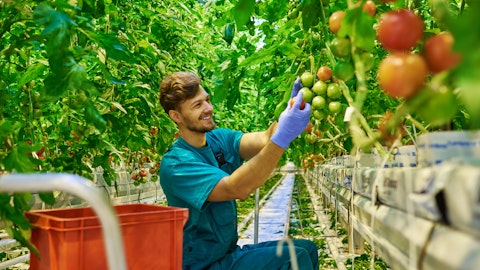And just to put that in perspective, specifically in Europe, we had that really strong fourth quarter because of supply chain. And if you remember, we were talking about the semi-finished inventories at the end of the third quarter last year. This year, they’re down about 70% — almost 70% versus where they were a year ago, because we’ve improved the supply chain, because we’ve been able to get these tractors and combines out of the factories and off to the farmers much more effectively through the course of the year. So we don’t expect that big fourth quarter, that massive fourth quarter we saw last year, specifically in Europe. And that’s going to create a year-over-year challenge for us bringing those numbers down a little bit relative to what you would have saw last year.
Operator: Our next question is from Mig Dobre with R.W. Baird. Please go ahead.
Mig Dobre: Thank you and good morning. Hopefully, I understood this correctly, but I mean, what I heard from your comments is that inventories, dealer inventories have largely normalized at this point, and it sounds that demand maybe is starting to soften a little bit. So, I’m kind of curious as to how you’re thinking about managing the channel as you look into 2024. Are you thinking a downward adjustment in production? And if that’s the case, is there some context that we should have about the first half versus second half as we think about next year?
Damon Audia: Yes. So I think, Mig, you’re right. The inventory levels at the dealers, generally speaking, have normalized over the last quarter, I would say, with a couple of caveats to that. North America, for example, we do know that the dealer inventory is just around six months or so. The third quarter is usually the highest level. If I strip out the low – the small ag portion of that, the dealer inventory is actually around about five months. So it’s still a little bit low so there’s still some opportunity there. If I look at Europe and Eric, in his opening remarks, talked about the inventory levels being at about four months, again, that’s an overall statement, but there are still a lot of areas where the Fendt high-horsepower tractor inventory at the dealers are below the optimal level for us.
So we still see some opportunities for some dealer fill there. But generally speaking, I would say inventory levels are normal. As we think about 2024, as we go through our budget planning process, the question is going to be about our market share initiatives and what we think we can gain relative to where we were in 2023, given some of the supply chain constraints. And that’s going to influence our production, especially as we see these markets potentially continuing to soften. So we don’t know how the production is going to shape out just yet. We’ll give you that update. But I would tell you, you should be thinking more about production aligned with overall demand as we think about 2024.
Mig Dobre: All right. That’s helpful. And I guess my follow-up, your North America margins, as you talked about already have been quite good. I’m, sort of, wondering about the sustainability of that going forward, especially as you talk about Fendt continuing to build momentum? Thank you.
Damon Audia: Yes. Again, I think, Mig, for us, North America has been a really good margin performance for us, and a lot of that is predicated on that Fendt’s market share expansion. We’ve talked about introducing Fendt to North America and South America. Adding these Fendt dealers and really focusing on that Fendt experience, we’ve talked about being very selective on how fast we roll Fendt out into the dealer networks who is able to offer it because they need to deliver on that overall Fendt experience, which includes the Gold Star warranty, the replacement tractors. So we’ve seen great growth, great share growth in North America. And again, if I think about that performance year-over-year, a lot of that or the majority of that is coming from the Fendt market share growth that we’re seeing or the Fendt performance in North America.
And as we’ve said in the past, we still see opportunities. Remember at our December Investor Day, we said that we are going to outpace the industry regardless of where we were in the cycle by 4% to 5%. One of in those three growth factors were going to be the Fendt market share, mainly in North America and South America. We remain convinced that, that is still an opportunity as we move forward into 2024 Precision Ag growth, which we’ve said is going to grow at around 15% per annum on average and then our parts growth. So those three are going to help us outpace the industry by 4% to 5%. And I think North America is showing that this quarter, and we remain confident in its potential going into next year.
Eric Hansotia: Yes. Just one more comment on that. We’ve grown the Fendt market participation in North America from about 40% market coverage to 70%, 75% market coverage with a step-by-step dealer expansion that Damon talked about. We expect to grow that from 75% up to 90%, 95% over the next couple of years, steadily only when the dealer earns it but much like we’ve been doing over the last few years. So there’s more market potential there to be able to experience the full Fendt overall brand promise. Same thing in South America.
Operator: The next question is from Steve Volkmann with Jefferies. Please go ahead.
Stephen Volkmann: Good morning, everybody. Eric, I think you talked about farmers becoming more selective in their capital spending. What does that mean exactly? Are you seeing sort of a mix shift in the types of equipment that they’re buying?
Eric Hansotia: I don’t know, if I’d say a mix shift. But I would say that, some of the applications, new applications for financing are cooling off. It’s coming back to more of a normal market. We’ve had such a hot market these last couple of years. But the mix is still oriented towards large ag. The growth is still very much in the Precision Ag retrofit business to make an existing machine more capable and more intelligent. Small ag is still, on a relative basis, weaker than large ag. So I don’t think it’s much more — much of a mix shift. It’s just a general — a little bit more caution on the farmer’s part.



